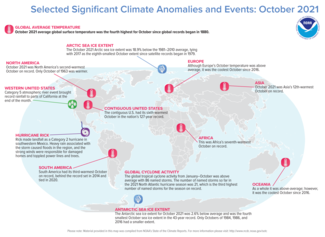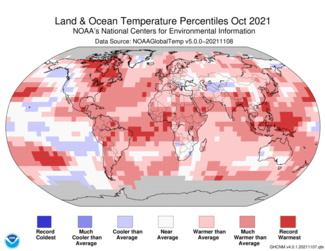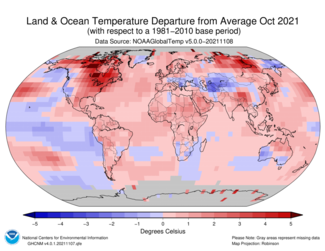Top-four warmest October; record warm October for the Northern Hemisphere land

The global temperature for October 2021 was the fourth highest for the month of October in the 142-year NOAA record, which dates back to 1880. The year-to-date (January-October) global surface temperature was the sixth highest on record. According to NCEI’s Global Annual Temperature Rankings Outlook, it is virtually certain (>99.0%) that the year 2021 will rank among the 10 warmest years on record.
This monthly summary, developed by scientists at NOAA’s National Centers for Environmental Information, is part of the suite of climate services NOAA provides to government, business, academia and the public to support informed decision-making.
Monthly Global Temperature
The October 2021 global surface temperature was 1.60°F (0.89°C) above the 20th-century average of 57.2°F (14.0°C) -- the fourth-warmest October in the 142-year record. Only the Octobers of 2015, 2018, and 2019 were warmer. The last eight Octobers (2014-2021) all rank among the eight warmest Octobers on record. October 2021 also marked the 45th consecutive October and the 442nd consecutive month with temperatures, at least nominally, above the 20th-century average.
During the month, unusually high October temperatures were present across much of North America and central Russia, as well as some locations across southwestern China and Antarctica, where temperatures were 4.5°F (2.5°C) above average or higher. Much of northern Canada and parts of the northeastern contiguous U.S. had record-warm October temperatures. The unusually warm temperatures across the Northern Hemisphere land resulted in the warmest October land temperature for the Northern Hemisphere on record. Meanwhile, North America as a whole had its second warmest October on record, behind the record set in 1963.
Other areas with much-warmer-than average temperatures included much of Central and South America, Africa, northern Europe, and parts of southern and eastern Asia, the Atlantic, and the Pacific and Indian oceans. Temperatures were cooler than average across parts of western North America, southern Africa, southeastern Europe, western and eastern parts of Asia, and parts of the north, central, eastern, and southeastern Pacific Ocean.
Regionally, South America had its third warmest October, while Africa and Asia had their seventh and 12th-warmest October on record, respectively. Although Europe and Oceania had an above-average October temperature, it was the coolest since 2016 for both continents.
Snow Cover and Sea Ice
According to data from NOAA and analysis by the Rutgers Global Snow Lab, the Northern Hemisphere snow cover extent during October was slightly above the 1981-2010 average at 7.0 million square miles. The North American snow cover extent was the ninth smallest on record for October, while Eurasia had a slightly above average snow cover extent and ranked as the 22nd largest for October.
The October 2021 Arctic sea ice extent was 610,000 square miles below the 1981-2010 average and tied with 2017 as the eighth smallest October sea ice extent. This also marked the 21st consecutive October with below-average sea ice extent. According to the National Snow and Ice Data Center (NSIDC), the sea ice extent across the Arctic has been growing quickly, with most of the Arctic Ocean being covered with ice at the end of October.
The Antarctic sea ice extent for October 2021 of 6.81 million square miles was 180,000 square miles below average. This was also the fourth smallest October sea ice extent on record. Only the Octobers of 1984, 1986, and 2016 had a smaller October sea ice extent on record.
Global Tropical Cyclones
During the month, there were 11 named storms globally, of which six became hurricanes and only one strengthened to major hurricane status (Category 3 or higher in the Saffir-Simpson scale). Typically, the month of October has four major hurricanes globally, two of which come from the West Pacific basin. However, during October 2021, there was only one major hurricane (Hurricane Sam) which was in the Atlantic basin.
The global tropical cyclone count from January-October 2021 was 86 named storms, which was above normal. Although the Atlantic basin had relatively limited hurricane activity in October, the number of named storms so far in the 2021 North Atlantic hurricane season was 21, which is the third highest number of named storms for the season on record. The eastern North Pacific basin had an above-average October with two hurricanes, while the West Pacific basin had near-average typhoon activity in October with five named storms.
For a more complete summary of climate conditions and events, see our October 2021 Global Climate Report.



